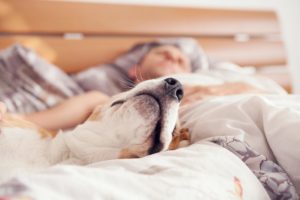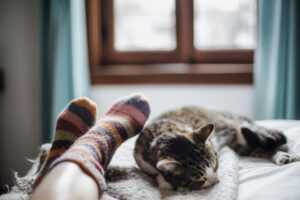How Many Hours a Day Do Dogs Sleep?
Dogs have an enviable life. After sleeping all night, they spend their days napping in sunbeams and dozing on the couch. When they do wake up, they’re often energetic enough for an immediate game of fetch. Animals like dogs sleep differently than humans do, and these differences can cause many dog owners to wonder if their dog is sleeping too much or not enough.
There’s more than one answer to the question of how many hours of sleep a dog needs every day. Like us, dogs may need more or less sleep depending on their age, health, location, and lifestyle. By learning more about how dogs sleep, it’s easier to understand your own dog’s sleep patterns and notice any changes or causes for concern.
How Many Hours a Day Do Dogs Sleep?
Dogs require a significant amount of sleep, even more than we do. However, the total amount of sleep a dog needs can vary depending on a range of factors. Of these, age is the most important and has the greatest impact on a dog’s sleep schedule.
- Puppies: Research is limited, but one study showed that puppies sleep at least 11 hours a day . While many puppies sleep less at night than adult dogs do, they sleep more hours during the day and sleep for longer overall. The majority of puppies also sleep in a crate or a kennel.
- Adult Dogs: Most adult dogs seem to need between eight and 13.5 hours of sleep every day, with an average of just under 11 hours. For comparison, most adult humans need seven to eight hours of sleep. Adult dogs sleep longer at night than puppies do — usually between 60% and 80% of the hours between 8 p.m. and 8 a.m. depending on their surroundings and their owner’s schedule. However, daytime naps are still important for adult dogs, who may sleep for up to 37% of the day . By the time they are one year old, most dogs sleep in a dog bed.
- Senior Dogs: Middle-aged and senior dogs tend to wake up less often throughout the night and sleep later in the morning . They also sleep more during the day, as they nap more frequently.
Signs Your Dog Isn’t Sleeping Enough
Dogs can adapt to most situations. A study of shelter dogs who slept less during the day due to the hustle and bustle of a shelter environment found that they slept more deeply at night and woke up less often. By sleeping for longer at night, these shelter dogs slept for an average of 11 hours per day — the same amount as most other adult dogs.
However, adapting to a busy environment may come with a cost. The same study found that dogs who sleep more during the day are more relaxed and appear happier, meaning that it is worth investigating if your dog does not sleep well.
There has been little research into the symptoms of sleep deprivation in dogs. However, anecdotal evidence suggests that they might mimic some of the symptoms of poor sleep in humans, which can include :
- More intense reactions to stressful stimuli
- Irritability and mood disturbances
- Poor memory
Sleep also appears to have a significant impact on a dog’s ability to learn. In one study, dogs who slept well after learning a new command performed better when tested a week later than dogs who did not.

Can Dogs Have Sleep Disorders?
Like humans, dogs can experience sleep disorders. The most common are narcolepsy, obstructive sleep apnea, and REM sleep behavior disorder.
Narcolepsy in Dogs
Canine narcolepsy is a chronic neurological disorder that causes symptoms like excessive daytime sleepiness and cataplexy. Often described as fainting, cataplexy involves sudden muscle weakness and loss of muscle control. Cataplexic episodes often occur when a dog is eating or playing.
Doberman pinschers, Labrador retrievers, and some other breeds sometimes suffer from narcolepsy because of inherited genetics , but narcolepsy also occurs in dogs without a family history of the disorder. While there is no cure for canine narcolepsy , the condition is not life-threatening and does not worsen with age. Not all dogs require treatment for their narcolepsy, but those with severe symptoms may be treated with anti-cataplectic medication.
Obstructive Sleep Apnea in Dogs
Obstructive sleep apnea is a sleep breathing disorder that occurs in many mammals , including humans and dogs. It occurs when relaxed tissue and muscles block the airway, causing short breathless periods called apneas. In both humans and dogs, some of the most common symptoms are excessive daytime sleepiness and loud snoring or choking noises during sleep.
Dogs with extremely short muzzles, like bulldogs, are more prone to sleep apnea than other breeds. Treatment usually involves surgery or medication , although your veterinarian may also suggest lifestyle changes like weight loss.
REM Sleep Behavior Disorder in Dogs
Rapid eye movement (REM) sleep behavior disorder is a condition that causes abnormal movements during the REM phase of sleep. Dogs with this disorder exhibit a range of behaviors while asleep , including howling or barking, violent limb movements, and biting or chewing. The majority of dogs first exhibit symptoms before they are 1 year old, and treatment with medication appears to be effective in over three-fourths of cases.
How to Help Your Dog Sleep Better
Most dogs are able to get the sleep they need to live relaxed and happy lives. However, there are some steps you can take to ensure that your dog’s routine and surroundings are set up to help them snooze.
- Set Up a Schedule: If your dog is struggling to relax, they may benefit from a set routine. Try keeping a similar schedule each day to see if this helps your dog rest more easily.
- Sleep Alone: Many people let their dog sleep with them, but this can disrupt both human and canine sleep patterns. These disruptions occur even when owners are unaware of them, meaning that you may not know if sharing a bed makes it harder for your dog to sleep.
- Make Their Bed Comfortable: Many people use a crate or kennel to contain young puppies and encourage them to sleep. Whether you continue to crate your dog as they age or transition them to a dog bed, it’s important that where they sleep offers both comfort and support. Older dogs or those with joint problems may require a more supportive bed.
- Keep Their Sleeping Area Quiet and Dark: Mammals have circadian rhythms that are influenced by light , so it’s easier for your dog to sleep at night if it’s dark or dim. It’s also easier for them to sleep if they aren’t being interrupted by excessive noise.
- Exercise: While there is little research into the relationship between sleep and exercise in dogs, we know that regular exercise appears to help humans sleep better . Anecdotal evidence suggests this is also true in dogs, particularly highly active working breeds.
- Allow for Periods of Relaxation in the Day: Unfamiliar or busy places, as well as unfamiliar people, can make it harder for your dog to sleep during the day. To help them get enough sleep, ensure they have periods without activities and access to quiet, familiar territory.

Still have questions? Ask our community!
Join our Sleep Care Community — a trusted hub of sleep health professionals, product specialists, and people just like you. Whether you need expert sleep advice for your insomnia or you’re searching for the perfect mattress, we’ve got you covered. Get personalized guidance from the experts who know sleep best.
References
15 Sources
-
Kinsman, R., Owczarczak-Garstecka, S., Casey, R., Knowles, T., Tasker, S., Woodward, J., Da Costa, R., & Murray, J. (2020). Sleep duration and behaviours: A descriptive analysis of a cohort of dogs up to 12 months of age. Animals: An Open Access Journal from MDPI, 10(7), 1172.
https://pubmed.ncbi.nlm.nih.gov/32664232/ -
Owczarczak-Garstecka, S. C., & Burman, O. H. P. (2016). Can sleep and resting behaviours be used as indicators of welfare in shelter dogs (canis lupus familiaris)? PloS One, 11(10), e0163620.
https://pubmed.ncbi.nlm.nih.gov/27732667/ -
Zanghi B.M., Kerr W., Gierer J., de Rivera C., Araujo J.A., Milgram N.W. Characterizing behavioral sleep using actigraphy in adult dogs of various ages fed once or twice daily. Journal of Veterinary Behavior, 2013, 8:195–203.
https://www.sciencedirect.com/science/article/abs/pii/S1558787812001979 -
Medic, G., Wille, M., & Hemels, M. E. (2017). Short- and long-term health consequences of sleep disruption. Nature and Science of Sleep, 9, 151–161.
https://pubmed.ncbi.nlm.nih.gov/28579842/ -
Kis, A., Szakadát, S., Gácsi, M., Kovács, E., Simor, P., Török, C., Gombos, F., Bódizs, R., & Topál, J. (2017). The interrelated effect of sleep and learning in dogs (canis familiaris); An EEG and behavioural study. Scientific Reports, 7, 41873.
https://pubmed.ncbi.nlm.nih.gov/28165489/ -
Mondino, A., Delucchi, L., Moeser, A., Cerdá-González, S., & Vanini, G. (2021). Sleep disorders in dogs: A pathophysiological and clinical review. Topics in Companion Animal Medicine, 43, 100516.
https://pubmed.ncbi.nlm.nih.gov/33556640/ -
Chen, L., Brown, R. E., McKenna, J. T., & McCarley, R. W. (2009). Animal models of narcolepsy. CNS & Neurological Disorders Drug Targets, 8(4), 296–308.
https://pubmed.ncbi.nlm.nih.gov/19689311/ -
Spady, T. C., & Ostrander, E. A. (2008). Canine behavioral genetics: Pointing out the phenotypes and herding up the genes. American Journal of Human Genetics, 82(1), 10–18.
https://pubmed.ncbi.nlm.nih.gov/18179880/ -
Tonokura, M., Fujita, K., & Nishino, S. (2007). Review of pathophysiology and clinical management of narcolepsy in dogs. The Veterinary Record, 161(11), 375–380.
https://pubmed.ncbi.nlm.nih.gov/17873267/ -
Chopra, S., Polotsky, V. Y., & Jun, J. C. (2016). Sleep apnea research in animals: Past, present, and future. American Journal of Respiratory Cell and Molecular Biology, 54(3), 299–305.
https://pubmed.ncbi.nlm.nih.gov/26448201/ -
Kopke, M. A., Wightman, P., & Ruaux, C. G. (2019). Obstructive sleep apnea in a Chihuahua successfully managed with ondansetron. Clinical Case Reports, 7(5), 872–876.
https://pubmed.ncbi.nlm.nih.gov/31110706/ -
Schubert, T. A., Chidester, R. M., & Chrisman, C. L. (2011). Clinical characteristics, management and long-term outcome of suspected rapid eye movement sleep behaviour disorder in 14 dogs. The Journal of Small Animal Practice, 52(2), 93–100.
https://pubmed.ncbi.nlm.nih.gov/21265848/ -
Hoffman, C. L., Browne, M., & Smith, B. P. (2020). Human-animal co-sleeping: An actigraphy-based assessment of dogs’ impacts on women’s nighttime movements. Animals: An Open Access Journal from MDPI, 10(2), 278
https://pubmed.ncbi.nlm.nih.gov/32054077/ -
Bertolucci, C., Fazio, F., & Piccione, G. (2008). Daily rhythms of serum lipids in dogs: Influences of lighting and fasting cycles. Comparative Medicine, 58(5), 485–489.
https://pubmed.ncbi.nlm.nih.gov/19004375/ -
Kline, C. E. (2014). The bidirectional relationship between exercise and sleep: Implications for exercise adherence and sleep improvement. American Journal of Lifestyle Medicine, 8(6), 375–379.
https://pubmed.ncbi.nlm.nih.gov/25729341/








